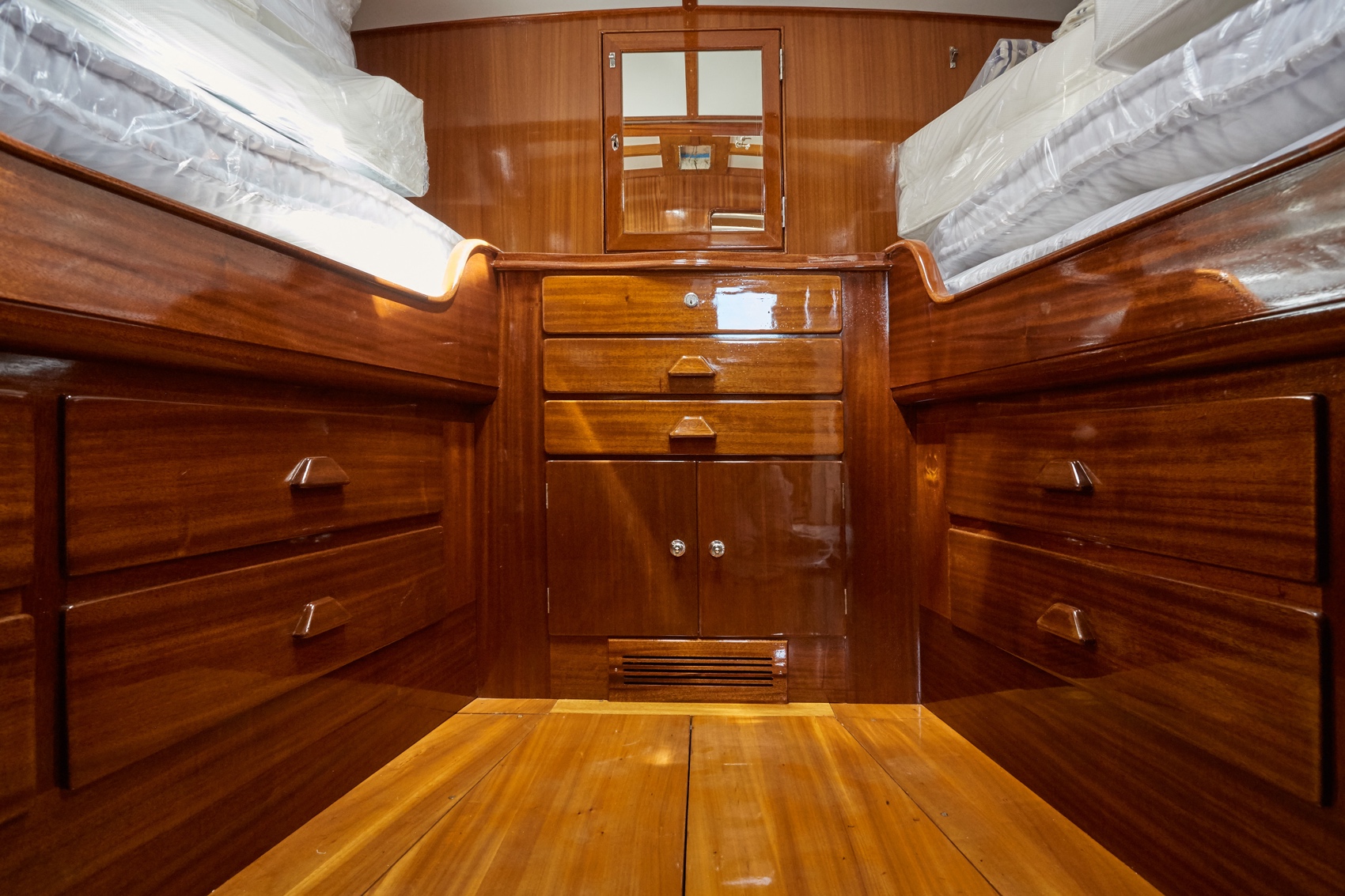IF YOU CAN DREAM IT WE CAN BUILD IT
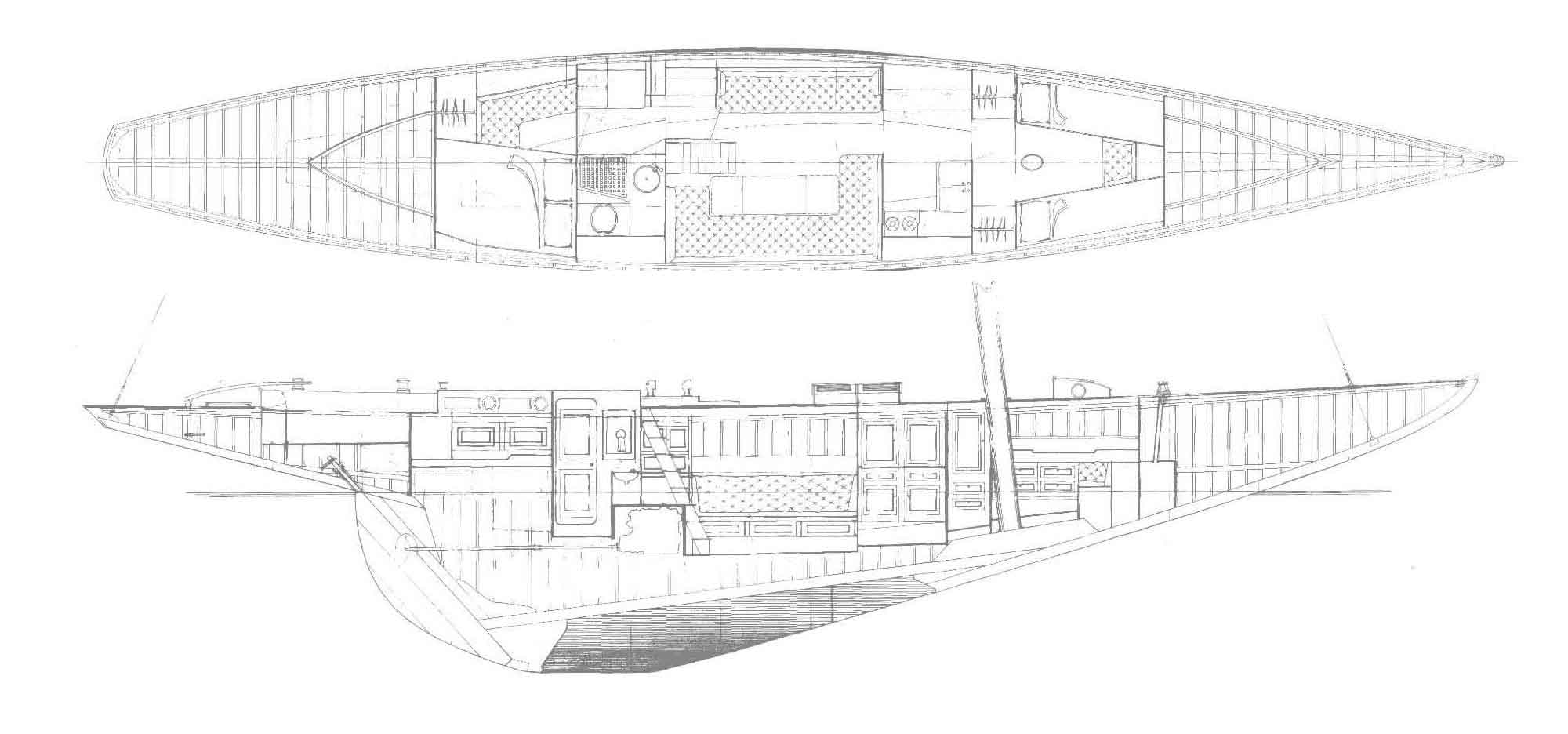
Sangermani,
a family and boats history
In Sangermani shipyard you will find experince, tradition and innovation, masterly mixed for create unique yachts in the world.
Sangermani shypiard has maintained his reputation in the design and construction of yachts for more than a century.
It’s a privilege to be able to say: “It’s a Sangermani!“

1896
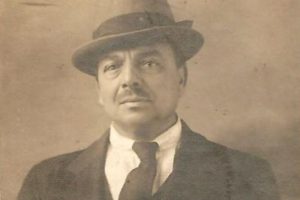 In the small workshop in Mulinetti (Recco) great-grandfather Ettore 'Dorin' Sangermano began building a boat for his newborn son. From the strong passion for the sea of the great-grandfather Dorin the shipyard start his life.
In the small workshop in Mulinetti (Recco) great-grandfather Ettore 'Dorin' Sangermano began building a boat for his newborn son. From the strong passion for the sea of the great-grandfather Dorin the shipyard start his life.
1906
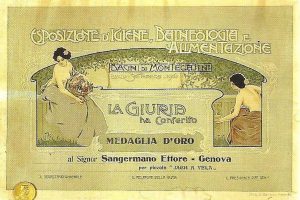 The first official recognition of Sangermani's construction and design skills was obtained at an important exhibition in Montecatini. Great-grandfather Dorin won the gold medal for a small sailing yacht entirely made by himself.
The first official recognition of Sangermani's construction and design skills was obtained at an important exhibition in Montecatini. Great-grandfather Dorin won the gold medal for a small sailing yacht entirely made by himself.
1928
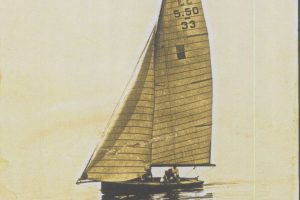 With the Vespa, the fast 5.50 just built, his sons Cesare and Piero Sangermani won the class championship in Bogliasco bay. In those years, Cesare and Piero continued their father's work with the same passion, no longer as a hobby, but turning it into a real profession.
With the Vespa, the fast 5.50 just built, his sons Cesare and Piero Sangermani won the class championship in Bogliasco bay. In those years, Cesare and Piero continued their father's work with the same passion, no longer as a hobby, but turning it into a real profession.
1934
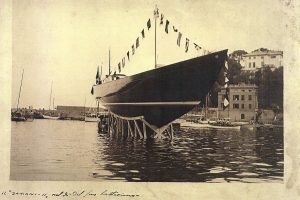 The space in Mulinetti became insufficient, the customers started asking for bigger boat and therefore the Sangermani brothers moved the shipyard to Rapallo. More than forty splendid yachts were launched here, including a 22-metre sloop, the Samani II, which due to its dimensions, exceptional for those times, is comparable to a mega yacht today.
The space in Mulinetti became insufficient, the customers started asking for bigger boat and therefore the Sangermani brothers moved the shipyard to Rapallo. More than forty splendid yachts were launched here, including a 22-metre sloop, the Samani II, which due to its dimensions, exceptional for those times, is comparable to a mega yacht today.
1942
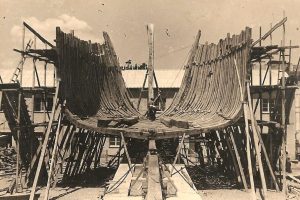 In wartime the Sangermani brothers were called to manage the Riva Trigoso shipyard. We are in wartime and production is mainly intended for war use. Under their leadership numerous ships, much larger than those they were familiar to building, were completed. Among these Solaro I, 40 metres, commissioned in 1945 by the Archbishop's Palace of Genoa.
In wartime the Sangermani brothers were called to manage the Riva Trigoso shipyard. We are in wartime and production is mainly intended for war use. Under their leadership numerous ships, much larger than those they were familiar to building, were completed. Among these Solaro I, 40 metres, commissioned in 1945 by the Archbishop's Palace of Genoa.
1946
 At the end of the Second World War the Sangermani brothers moved the shipyard to Lavagna. The identified area is at the mouth of the Entella. It's the ideal place for the construction site! The beach in front for hauling and launches and the road behind to be easily reached by suppliers and customers.
At the end of the Second World War the Sangermani brothers moved the shipyard to Lavagna. The identified area is at the mouth of the Entella. It's the ideal place for the construction site! The beach in front for hauling and launches and the road behind to be easily reached by suppliers and customers.
1950
 Sangermani international production begins with the creation of more than 70 boats in the following 10 years. Several III class RORC were builded. Royal Oceanic Racing Club and many other yachts are built including Chiar di Luna, Artica II, Viola, Alcor and Emi, a sloop of almost 27 meters.
Sangermani international production begins with the creation of more than 70 boats in the following 10 years. Several III class RORC were builded. Royal Oceanic Racing Club and many other yachts are built including Chiar di Luna, Artica II, Viola, Alcor and Emi, a sloop of almost 27 meters.
1960
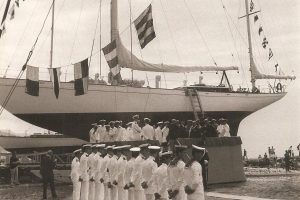 Under the wise guidance of Cesare Sangermani Sr, defined as the guru of pleasure boating, and his brother Piero, increasingly larger boats were built, commissioned by prominent figures. In the following 10 years, more than 60 sailing yachts were built including Stella Polare for the Navy, Oliana IV, Cigno Nero, Patricia II, Samurai, Telstar, Tortuga III and Gitana IV for Baron Rothschild.
Under the wise guidance of Cesare Sangermani Sr, defined as the guru of pleasure boating, and his brother Piero, increasingly larger boats were built, commissioned by prominent figures. In the following 10 years, more than 60 sailing yachts were built including Stella Polare for the Navy, Oliana IV, Cigno Nero, Patricia II, Samurai, Telstar, Tortuga III and Gitana IV for Baron Rothschild.
1965
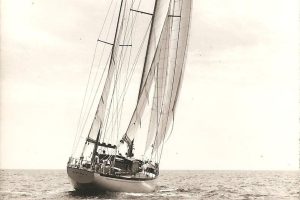 The Gitana IV stands out for its victory in the Fastnet regatta, lowering the time record by eleven hours; record remained unbeaten for many years.
The Gitana IV stands out for its victory in the Fastnet regatta, lowering the time record by eleven hours; record remained unbeaten for many years.
1970
 The great evolution of Italian yachting. Boats designed by famous naval architects were built, including Laurent Giles, Sparkman & Stephens, Illingworth, Angus Primrose, Anselmi Boretti, Reiners, Philip Rhodes, Buchanan, Alan Gurney, German Frers, Carlo Sciarrelli and Gary Mull. In the following 10 years, more than 30 hulls were built, many of which were designed by Cesare Sangermani Sr. Among others, the Seljm yacht was built, counted among the largest pleasure sailing hulls ever built in the world.
The great evolution of Italian yachting. Boats designed by famous naval architects were built, including Laurent Giles, Sparkman & Stephens, Illingworth, Angus Primrose, Anselmi Boretti, Reiners, Philip Rhodes, Buchanan, Alan Gurney, German Frers, Carlo Sciarrelli and Gary Mull. In the following 10 years, more than 30 hulls were built, many of which were designed by Cesare Sangermani Sr. Among others, the Seljm yacht was built, counted among the largest pleasure sailing hulls ever built in the world.
1971
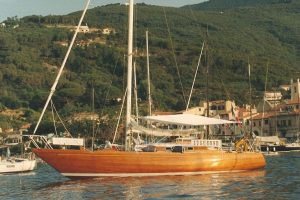 Cesare Sangermani Jr wins the Giraglia at the helm of "Mania", a 10.60 meter built entirely in mahogany in 1969. Given its beauty and elegance, journalists defined it as "the Stradivarius of the sea”.
Cesare Sangermani Jr wins the Giraglia at the helm of "Mania", a 10.60 meter built entirely in mahogany in 1969. Given its beauty and elegance, journalists defined it as "the Stradivarius of the sea”.
1978
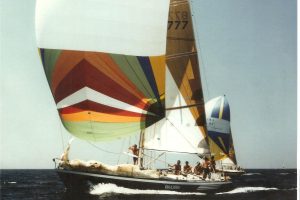 The leadership of the shipyard passes to Cesare Sangermani Jr. Advanced composite materials are introduced into the construction of yachts: epoxy resins, fibreglass, aluminum honeycomb, Kevlar, carbon and nomex. Cutting-edge hulls such as Guia 2000 and Rolly Go are created, brought to success by Giorgio Falck.
The leadership of the shipyard passes to Cesare Sangermani Jr. Advanced composite materials are introduced into the construction of yachts: epoxy resins, fibreglass, aluminum honeycomb, Kevlar, carbon and nomex. Cutting-edge hulls such as Guia 2000 and Rolly Go are created, brought to success by Giorgio Falck.
1980 and following
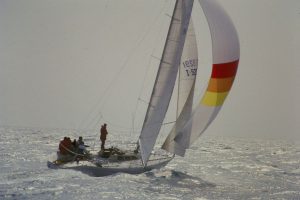 Thanks to the important collaborations with some of the major experts in the sector, from Luca Olivari to Eng. Fabio Buzzi, some experimental prototypes, both sailing and motor, have been launched and have won international regattas and events. Among others, we mention Articolo V, the offshore Flash and the catamarn Ottovolante. The production of pleasure yachts also continues with the creation of other important hulls such as Luciana, Masa Yumè, Rorolima, Luja and Sampei.
Thanks to the important collaborations with some of the major experts in the sector, from Luca Olivari to Eng. Fabio Buzzi, some experimental prototypes, both sailing and motor, have been launched and have won international regattas and events. Among others, we mention Articolo V, the offshore Flash and the catamarn Ottovolante. The production of pleasure yachts also continues with the creation of other important hulls such as Luciana, Masa Yumè, Rorolima, Luja and Sampei.
1990 and following
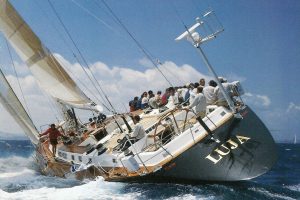 Experimental techniques, such as W.E.S.T. System used since 1986, lead to the construction of new sailing and motor yachts such as Pegasus, Dalu, Secondo Pensiero by Gianni Lancia, the brigantine Barbarossa, the maxi yacht Luya and Wallygator by Luca Bassani. At the end of the 1990s, Desirade II was built, a maxi yacht of over 28 metres.
Experimental techniques, such as W.E.S.T. System used since 1986, lead to the construction of new sailing and motor yachts such as Pegasus, Dalu, Secondo Pensiero by Gianni Lancia, the brigantine Barbarossa, the maxi yacht Luya and Wallygator by Luca Bassani. At the end of the 1990s, Desirade II was built, a maxi yacht of over 28 metres.
2000
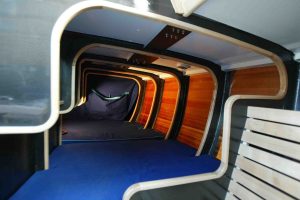 Thanks to the experience of Cesare Sangermani Jr and his continuous experimentation, the XILON 3.0 construction system was patented which allowed the implementation of cutting-edge materials in the traditional construction method, contributing in a natural way to the modernization process of the shipyard.
Thanks to the experience of Cesare Sangermani Jr and his continuous experimentation, the XILON 3.0 construction system was patented which allowed the implementation of cutting-edge materials in the traditional construction method, contributing in a natural way to the modernization process of the shipyard.
2010 nowadays
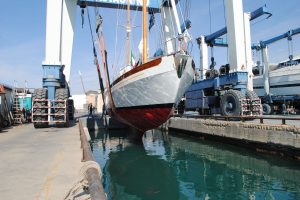 Presently the management of the construction site has been renewed with the fourth generation. Cesare Sangermani Jr's sons, Filippo and Giacomo, continue the family business, expanding the sheds in Lavagna and renovating the boats built by their grandfather Cesare. In these years Seconda Santa Lucia, Beatrice, Viola, Tulli, Umiak, Leticia do Sol and many others return to being the splendid ladies of the sea that they had been in the past.
Presently the management of the construction site has been renewed with the fourth generation. Cesare Sangermani Jr's sons, Filippo and Giacomo, continue the family business, expanding the sheds in Lavagna and renovating the boats built by their grandfather Cesare. In these years Seconda Santa Lucia, Beatrice, Viola, Tulli, Umiak, Leticia do Sol and many others return to being the splendid ladies of the sea that they had been in the past.

Tradition and innovation,
harmony achieved over time
Symbols of a new era of sailing, Sangermani yachts offer the latest innovations in the nautical world, providing a perfect balance of breathtaking performance, ease of use and unique design; every aspect and every component is developed to work in total harmony.
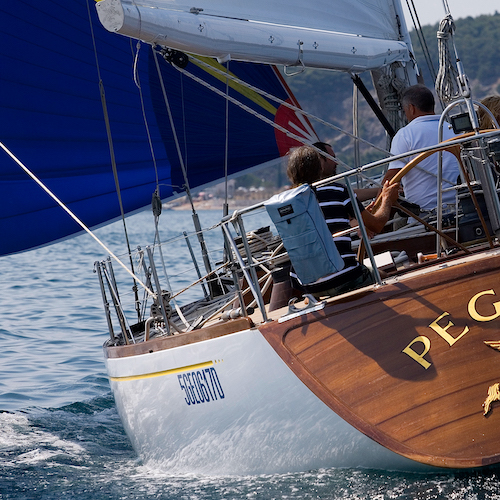
Our passion for perfection is reflected in the uncompromising performance of every Sangermani boat.
Creating your boat is an important team effort.
No cost or effort is spared, every detail exemplifies an inspired commitment to excellence.

Sangermani in the world
